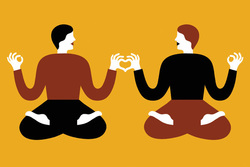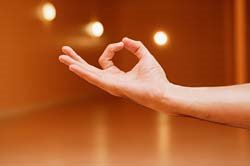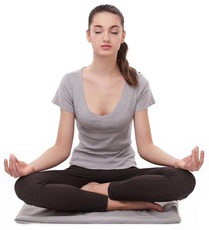This meditation focuses on posture, breath and chanting. In kundalini, it's really important to focus on the details of the practice. Each one is specifically designed to have the most impact it can, so try to practice this exactly as it's suggested.
Start in a sitting position, in lotus or simply with legs crossed. You can also do this in a chair (nice to keep in mind if you're stressed at the office or on a long flight!)
Sit up tall with your spine straight and your chin slightly tucked. Rest your hands, palms up, on your knees. Close your eyes and focus your attention to your third eye center (the space between your eyebrows)
Now you can start the practice:
Chant:
"SA" while touching your thumbs and index fingers together
"TA" while touching your thumbs and middle fingers together
"NA" while touching your thumbs and ring fingers together
"MA" while touching your thumbs and pinky fingers together
Everytime you chant one of those words, you press your thumb and corresponding finger together on each hand at the same time.
Once you get the hang of touching your fingers and thumbs together with the syllables, you can begin to visualize the sounds moving from the crown of your head through your third eye space.
Repeat this chant/practice for 2 minutes. Then whisper the chant and continue touching your fingers along with your whisper for another 2 minutes. Then repeat the chant silently while touching your fingers for 3 minutes. Then bring it back to the whisper chant for 2 minutes and finish with the full chant for a final 2 minutes. Complete the chanting at 11 minutes.
Once completed, take an inhale and raise your arms overhead. Shake them out! This is important for moving and releasing your energy. Exhale and relax for a bit.
If you're going though an especially challenging and stressful time, practice this 11 minute version everyday. You can work up to 31 minutes if needed.
a few things to note
This is considered one of the most important meditations in kundalini yoga and if you only do one, this should be it. so take your time and focus on the practice.
always visualize the energy moving from the crown of your head and out through your third eye center with each syllable. this is important! you don't want that energy to become stuck.
practice for a minimum of 11 minutes.
what do the syllables actually mean?
SA: the beginning, the infinity, the totality of everything that ever was and will be
TA: life, existence and creativity that manifests from infinity
NA: change and transformation of consciousness
MA: rebirth and regeneration
Ready to try it?
Get comfortable. Close your eyes. And chant along with this music to help you get started!
xo, b







 RSS Feed
RSS Feed
